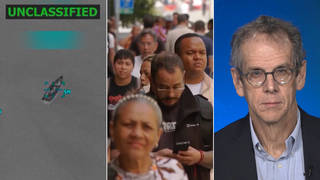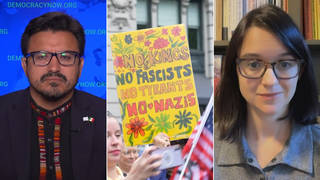
Guests
- Maya Littleactivist and doctoral student at the University of North Carolina, Chapel Hill. She faces charges of property destruction and possible expulsion for pouring red ink and her own blood on the statue during a protest earlier this year.
We end today’s show in North Carolina, where hundreds of student protesters in Chapel Hill toppled the “Silent Sam” Confederate statue at the University of North Carolina Monday night, on the eve of the first day of classes. The statue was erected in 1913 to honor Confederate soldiers, and has been the target of repeated protests. For more, we speak with Maya Little, UNC doctoral student facing charges of property destruction and possible expulsion for pouring red ink and her own blood on the statue during an earlier protest in April.
Transcript
AMY GOODMAN: We end today’s show in North Carolina, where hundreds of student protesters in Chapel Hill toppled the Silent Sam Confederate statue at University of North Carolina Monday night, on the eve of the first day of classes. The statue was erected in 1913 to honor Confederate soldiers. It’s been the target of repeated protests. Video footage shows protesters surrounding the statue with tall banners. Then the statue was toppled.
This is UNC, University of North Carolina, doctoral student Maya Little speaking at Monday’s protest. She herself faces charges of property destruction and possible expulsion for pouring red ink and her own blood on the statue during an earlier protest in April. But this is Maya Monday night.
MAYA LITTLE A statue that advocates violence against us, that honors slave owners. At this statue I have felt degraded, and I have also been harassed. I have been surveilled by police. I have been called a nigger. I have been told that I will be hung from the tree right above Silent Sam.
AMY GOODMAN: Protesters later tried to bury the toppled statue’s head, but officials took it away. Silent Sam, as the statue is called, is just the latest Confederate monument to come down in North Carolina, around the United States. In recent months, a Confederate Soldiers Monument in Durham was toppled last August, two days after the Unite the Right rally in Charlottesville, Virginia, where a woman was killed protesting the white supremacists. In December, work crews removed two Confederate statues from parks in Memphis, Tennessee. Civil War-era landmarks and Confederate monuments also came down in New Orleans and Baltimore.
For more, we’re going to Durham, North Carolina, to speak with Maya Little, the activist and doctoral student at the University of North Carolina who you just heard her speaking Monday night.
Maya, talk about the significance of the toppling of this statue.
MAYA LITTLE: For me, it’s very significant. This has been a very long battle with the university. The first time the statue was vandalized or painted was in 1968, the day after Martin Luther King was assassinated. Fifty years later, the members of our community—students, workers and people of our community—took it upon themselves to do what UNC wouldn’t do, and remove the statue and memorialize those who have lost their lives to white supremacy.
AMY GOODMAN: So, talk about what you did in April and what you’ve been charged with.
MAYA LITTLE: In April, I did what I’ve been doing this past year, which is adding historical context to the white supremacist monument known as Silent Sam. I poured my blood and red ink on the statue, because it sits sanitized, and yet it’s founded on this idea of violence towards black people. It was dedicated—during the dedication speech, Julian Carr talked about whipping a black woman until her skirt was in shreds, on university grounds. It was christened by this notion of violence towards black people. And for it to sit at the university without that context is historically wrong.
AMY GOODMAN: Can you talk about the charges you’re facing right now?
MAYA LITTLE: Right now I’m facing criminal charges for vandalism. I’ll be tried in Orange County, which is very historic in many ways. Orange County is the same place that James Lewis Cates’ murderers were tried in 1973. It is also the same place that Bayard Rustin and many of the first Freedom Riders were tried, after being stopped in Chapel Hill. My court date is October 15th at 9 a.m.
AMY GOODMAN: And talk about what you did in April.
MAYA LITTLE: Again, I threw my blood and red ink on the statue. I was providing the context that I, as a black person, and the other black students, workers and community members who have to walk by that—who had to walk by that statue and be degraded every day had to see, which is a literal noose hanging on our campus, which is a memorial to violence towards black people, to the people who enslaved my ancestors and sold their children. By pouring my blood and red ink on the statue, I hoped to contextualize it.
AMY GOODMAN: Your chancellor, the chancellor of the University of North Carolina, Carol Folt, called the removal of the Silent Sam statue Monday night “unlawful and dangerous.” But she did acknowledge on Tuesday, in an open letter, that the statue, quote, “has been divisive for years, and its presence has been a source of frustration for many people not only on our campus but throughout the community.” What is your response to what she has said?
MAYA LITTLE: Oh, well, in fact, I think what was actually unlawful and dangerous was the chancellor’s decision to not act, to in fact only act around Silent Sam to harass and use university police to spy on student protesters and anti-racist activists. What is actually unlawful and disrespectful is forcing black students to study on a campus with buildings named after slave owners, to study on a campus in which the forefront was a memorial to the people who enslaved their ancestors, who continued to disenfranchise, murder and commit violence towards them in the 1920s and during Jim Crow.
AMY GOODMAN: I wanted to—
MAYA LITTLE: So I would say, in fact, that Chancellor Folt’s response and the university’s response, which was to punish and to target anti-racist activists, was much more unlawful, much more disrespectful, than what many community members did, which was courageously remove the statue.
AMY GOODMAN: I wanted to go back to that story you told about the white supremacist industrialist Julian Carr speaking at the 1913 unveiling of the Silent Sam statue on the UNC campus, an alumni, was also a veteran of the Civil War. He spoke about how, just a hundred yards from the statue, he had, in the weeks immediately after the end of the Civil War, personally horse-whipped a black woman, quote, “until her skirts hung in shreds, because upon the streets of this quiet village she had publicly insulted and maligned a Southern lady, and then rushed for protection to these University buildings where was stationed a garrison of 100 Federal soldiers. … I performed the pleasing duty in the immediate presence of the entire garrison, and for thirty nights afterwards slept with a double-barrel shot gun under my head,” he said. So describe your feelings, Maya, on Monday night when the Silent Sam statue was toppled, a few months after you had thrown your own blood on the statue.
MAYA LITTLE: It was one of the most beautiful things I’ve ever seen at UNC—students, workers and community members coming together to memorialize, to take our streets back from racists, with badges and without badges, and to topple that statue.
AMY GOODMAN: And can you describe exactly how it went down Monday night?
MAYA LITTLE: I’m not sure, actually.
AMY GOODMAN: And what would you—
MAYA LITTLE: We saw it all come down.
AMY GOODMAN: Go ahead.
MAYA LITTLE: It made like a really mighty sound, fell into the dirt, and we all cheered.
AMY GOODMAN: They wanted to bury the head?
MAYA LITTLE: I think many people threw dirt on the head. I mean, again, we’ve been struggling against this statue, against institutional white supremacy at UNC, for so long, since black students have been at this university. And the community around this area has also struggled with white supremacy at UNC. It was a joyous moment for students and for workers and for community members to know that we are able to defend ourselves and to protect our community and to stop racism and white supremacy within it.
AMY GOODMAN: Maya Little, what would you like to see the statue replaced by?
MAYA LITTLE: I think that UNC has the opportunity to honor the resistance to white supremacy at UNC by erecting statues to people who have fought against this white supremacy, and also those who have been murdered by it. It would be nice to see a memorial to James Lewis Cates, who was murdered in UNC’s Pit in 1970 by a white supremacist motorcycle gang. It would be lovely to see a memorial to Jesus Huerta, who was murdered by police in Durham. It would be lovely to see a memorial to that unnamed black woman who rushed to the university campus for safety and was beaten by Julian Carr.
AMY GOODMAN: Maybe there will be a statue for you, Maya Little. What message do you have for President Trump today?
MAYA LITTLE: I think the same message that we’ve had for Chancellor Folt and others: When they do nothing to protect us, when they do nothing to protect black and brown people in this country, we fight back. We take things into our own hand, and we protect ourselves and fight against racism. And that’s what we’ll continue to do.
AMY GOODMAN: What are you majoring in? What is your doctorate in?
MAYA LITTLE: I study recent Chinese history.
AMY GOODMAN: Well, I want to thank you so much for being with us, University of North Carolina doctoral student Maya Little, arrested earlier this year for dousing the Confederate Silent Sam memorial with red paint and her own blood. That statue was toppled on Monday night.











Media Options